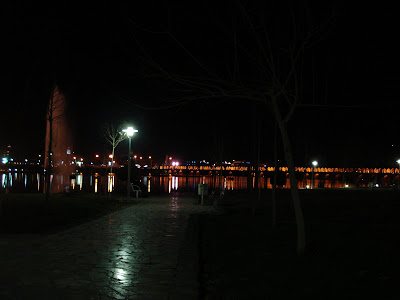By This River
A couple of months ago, a friend sent me a picture of the Zayandeh Rud in Esfahan which had more or less vanished at that time. A dam west of the city had been closed in the summer because of the severe drought in recent years. The water, which in any case evaporates in the desert in the Batlaq-e Gaykhunia, a huge marsh area about one hundred kilometers east of Esfahan, was urgently needed for agriculture. When I visited Esfahan in December, the riverbed was filled again, even though not to levels I had seen before.
The bridges over the river are world-famous. The river banks are carefully gardened, beautiful parks in the tradition of Persian Paradise gardens. They invite to stroll, rest, meet other people, let the children play, have a picnic. In fact, you may see married and even unmarried couples (although, you'll never know).
It is a six kilometers walk from Marnan Bridge in the west to Sharestan Bridge in the east, but when the weather is fine, a very pleasant trip.







Esfahan's centrepiece is, of course, gorgeous Si-o-seh Pol, the bridge with the thirty-three arches. It was built around 1600. Unfortunately, the marvellous tea houses at either end of the bridge have been closed down recently (I suppose because of drug problems). The bridge (and dam) was built by Allahverdi Khan, a favourite general of Shah Abbas I, in order to link the northern part of the new city's main boulevard, Khiaban-e Chahar Bagh-e Abbasi, with its southern half, Chahar Bagh-e Bala.




The next Safavid bridge is Chubi with twenty-one arches and two parlors. It was built by Shah Abba II in 1665. Sad to say that the tea houses have vanished, too.







 The next highlight is, of course, Khaju Bridge. The 17th century Safavid bridge, which was built by Shah Abbas II, also serves as a dam holding the water. It is a wonderful meeting place for lovers of all ages. Young men are spontaneously making music (but beware of the religious police and some fanatic chador-wearing women, either self-named or official guardians of public morals, who are keeping a jealous watch). The bridge is 132 meters long and has two levels of arcades which are beautifully decorated with paintings and tiles. At both sides, a marble lion is watching its counterpart on the banks of the river. At night, you may see the eyes of the beast on the other side of the bridge glowing, an ingenious construction using the reflection of light coming from somewhere.
The next highlight is, of course, Khaju Bridge. The 17th century Safavid bridge, which was built by Shah Abbas II, also serves as a dam holding the water. It is a wonderful meeting place for lovers of all ages. Young men are spontaneously making music (but beware of the religious police and some fanatic chador-wearing women, either self-named or official guardians of public morals, who are keeping a jealous watch). The bridge is 132 meters long and has two levels of arcades which are beautifully decorated with paintings and tiles. At both sides, a marble lion is watching its counterpart on the banks of the river. At night, you may see the eyes of the beast on the other side of the bridge glowing, an ingenious construction using the reflection of light coming from somewhere.

























Comments